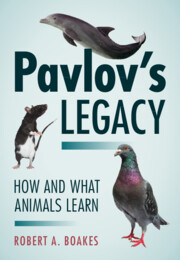Book contents
- Pavlov’s Legacy
- Pavlov’s Legacy
- Copyright page
- Contents
- Preface
- Acknowledgments
- 1 Ivan Pavlov, Conditioned Reflexes and Experimental Neuroses
- 2 Developing Habits
- 3 Learning Where Things Are and Where Events Happen
- 4 Fear, Avoidance, and Punishment
- 5 Comparative Psychology
- 6 Imprinting and Constraints on Learning
- 7 Discrimination Learning, Attention and Stimulus Generalization
- 8 B.F. Skinner and the Experimental Analysis of Behavior
- 9 How Animals Learn to Associate Events
- Notes
- References
- Index
3 - Learning Where Things Are and Where Events Happen
Published online by Cambridge University Press: 07 October 2023
- Pavlov’s Legacy
- Pavlov’s Legacy
- Copyright page
- Contents
- Preface
- Acknowledgments
- 1 Ivan Pavlov, Conditioned Reflexes and Experimental Neuroses
- 2 Developing Habits
- 3 Learning Where Things Are and Where Events Happen
- 4 Fear, Avoidance, and Punishment
- 5 Comparative Psychology
- 6 Imprinting and Constraints on Learning
- 7 Discrimination Learning, Attention and Stimulus Generalization
- 8 B.F. Skinner and the Experimental Analysis of Behavior
- 9 How Animals Learn to Associate Events
- Notes
- References
- Index
Summary
This chapter centers on the work of Hulls arch critic, Edward Tolman. He was convinced that the Pavlov-inspired approach to the study of learning was far too narrow. Using a variety of mazes, Tolman and his students obtained evidence that their rats could anticipate events - rather just make conditioned responses - and could learn about the spatial properties of environments they were placed in. In the late 1960s various researchers - most with little connection to Tolman - discovered the important role of the context in which an animal was conditioned. In the 1970s experiments by neuroscientists on the function of the hippocampus led to a revival of interest in spatial learning and renewed appreciation of Tolmans suggestion that animals form representations - maps - of their environment.
- Type
- Chapter
- Information
- Pavlov's LegacyHow and What Animals Learn, pp. 51 - 69Publisher: Cambridge University PressPrint publication year: 2023

